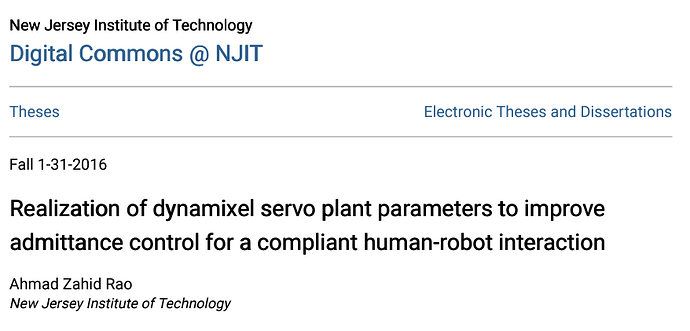ABSTRACT
REALIZATION OF DYNAMIXEL SERVO PLANT PARAMETERS TO
IMPROVE ADMITTANCE CONTROL FOR A COMPLIANT
HUMAN-ROBOT INTERACTION
by
Ahmad Zahid Rao
In theory, admittance control offers a very effective method of implementing smooth
human-robot interaction. It allows the user’s applied force to control the movement of a
powerful robot as if the robot were a small, passive mass. However, the real-world
application of admittance control faces limitation posed by the dynamics of servo motors,
the accuracy of the force sensors, and the computation speed of processors.
This research investigates the limitations on achieving compliant passive behavior
when using state-of-the-art actuators, sensors and processors. The work involves
characterizing the dynamic behavior of the servo motors, development of improved
differential equations representing admittance control, and testing to determine the ability
of a robotic system to represent the behavior of passivity. A method has been developed
for experimentally determining the inertial, and dissipative (damping and friction)
characteristics of three different models of Dynamixel motors. These parameters are
optimized using data from a pendulum drop test with mass at various distances from the
center of rotation. With these parameters, we assess the ability of our motor model to
generate an ideal motion based upon a torque input from the user. The aim is to
understand the limitations of our control paradigm to allow users to be unable to feel any
difference between the performances of the passive and motor joints.
Realization of dynamixel servo plant parameters to improve admitt.pdf (10.4 MB)
Academic paper featuring our DYNAMIXEL MX Series all-in-one smart actuators
All credit goes to Ahmad Zahid Rao from New Jersey Institute of Technology
